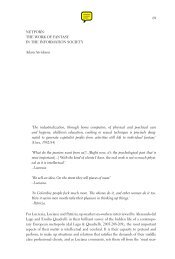Nakamura, Digitizing Race, Introduction, chapter 5, Epilogue
Nakamura, Digitizing Race, Introduction, chapter 5, Epilogue
Nakamura, Digitizing Race, Introduction, chapter 5, Epilogue
You also want an ePaper? Increase the reach of your titles
YUMPU automatically turns print PDFs into web optimized ePapers that Google loves.
Notes to Chapter 3 219<br />
to create their own iPod-style images. The article, titled “I See Ipod People: The<br />
Photoshop Silhouette,” explains that “if you’re crazy about those ipod ads and want<br />
to make one yourself, it’s actually pretty easy.” See http://www.photoshopsupport<br />
.com/tutorials/jennifer/ipod.html.<br />
31. Manovich, The Language of New Media, 77.<br />
32. Springer, “Playing It Cool in the Matrix,” 91; Alexander, “Cool like Me,” 49.<br />
33. Stross, “After 20 Years, Finally Capitalizing on Cool.” See also Liu, The Laws<br />
of Cool, on the intimate association of “cool” with digital networked technologies:<br />
“Cool is (and is not) an ethos, style, feeling and politics of information” (179).<br />
34. I wish to thank the artist for permission to reprint “iPod Ghraib,” which he<br />
has described as “Internet based.” See Trek Thunder Kelly’s Web site at http://<br />
www.trekkelly.com/garage/ipod-ghraib/ for this and other examples of digitally created<br />
images from his “Super-Pop” series. His “rebrands,” “crossbrands,” “real art,”<br />
and “celebrity rebrands” superimpose corporate iconography from brands such as<br />
Prada and Calvin Klein on photographic and painted images of Sitting Bull and<br />
Frida Kahlo, blending the languages of modern advertising and art. The “iPod<br />
Ghraib” images are one of a series of “rebrands” along with “Target© Iraq,” “Microsoft<br />
Soup,” and “Xerox Windex.” The artist’s Web site explains: “Re-branding substitutes<br />
familiar brands in an effort to expose their embedded meanings by bringing<br />
them out of context.”<br />
35. Sontag, “Regarding the Torture of Others.”<br />
36. See Shaviro, Connected, and Pisters, The Matrix of Visual Culture, for examples<br />
of this type of critique.<br />
37. Gilroy, Against <strong>Race</strong>, 23.<br />
38. Ansen, “Murder on the Spielberg Express.”<br />
39. Elmer, Profiling Machines, 73 (italics mine).<br />
40. See Matrix, Cyberpop, for an incisive reading on the ways in which Gattaca<br />
comments on racial identity in relation to biometrics, passing, and genetic engineering.<br />
41. Mark Williams, “Closely Belated?”<br />
42. Oliver, Witnessing, 151.<br />
43. Palumbo-Liu, Asian/American, 93.<br />
44. Gilroy, Against <strong>Race</strong>, 19.<br />
45. Scheper-Hughes, “The Global Traffic in Human Organs,” 193. Fears that<br />
traffic in human organs will reflect geopolitical power imbalances and perpetuate<br />
racism have been evident in literature such as the work of the Ghanaian novelist<br />
and theorist Ama Ata Aidoo since the 1970s. In Our Sister Killjoy, Aidoo confronts<br />
techno-utopians by writing: “Anyway, the Christian Doctor has himself said that in<br />
his glorious country, niggerhearts are so easy to come by....Yet she had to confess<br />
she still had not managed to come round to seeing Kunle’s point: that cleaning the<br />
Baas’s chest of its rotten heart and plugging in a brand-new, palpitatingly warm<br />
kaffirheart, is the surest way to usher in the Kaffirmillennium” (100–101).<br />
46. See Sassen, Globalization and Its Discontents.<br />
47. Castells, End of Millennium, 68.<br />
48. Ibid.<br />
49. Wood, “The Metaphysical Fabric That Binds Us,” 11.<br />
50. Foster, “The Transparency of the Interface,” 70.





